THE BEST ELECTRIC BIKE PUMP

While I’m an insatiable tester of the latest road and gravel wheels and tires, I’ve historically been an incurious traditionalist when it comes to inflating tires.
But within days of testing six compact, easy to use, and accurate electric bike pumps, I retired the floor pump I used in my garage workshop, the CO2 inflators and cartridges I kept in my road and gravel bike bags, the hand pump I carried on my gravel rides, and the digital gauge I used every time I pumped up a tire.
In this review, I’ll tell you why I’ve totally transformed and greatly simplified the way I blow up tires, what you can expect from the best electric bike tire inflators available now, and which I recommend.
MY TRADITIONAL BIKE TIRE INFLATION TOOLS
I’d long used a basic floor pump with an analog dial to inflate the tubes in my clincher tires and top them off before each ride. When I started testing and then converted to tubeless tires, I bought a basic compressor to fill and easily seat those tires onto each new wheelset. I continued using the floor pump to top off my tubeless tires before rides.
When I realized how much of a difference a couple of psi could make to my ride comfort and speed, I picked up a digital gauge to precisely set my preferred pressure levels right after pumping up my tires.
I’ve always carried a CO2 inflator, a couple of cartridges, and a spare tube in my road bike saddle bag.
On gravel rides, I packed another CO2 inflator, two cartridges, a spare tube in my bento bag, and a hand pump on my frame. I’d also bring my digital gauge along in case I flat or want to adjust the pressure for long stretches of different paved and gravel surfaces.
For day-long events, I’d carry an extra tube or two, two to three more CO2s, and 60 grams of sealant in a container that goes in the bottle cage on the underside of my downtube.
A Dynaplug tire repair tool with two plugs stays in my back pocket on every road ride, and a six-plug kit rides shotgun on my gravel rides.
THAT WAS THEN. THIS IS NOW
In one of those head-slapping, duh moments, I realized that the best electric bike pumps could replace all of those tools – indeed, everything except my compressor – and do their jobs more efficiently.
The electric bike tire pumps I recommend are the size of a GoPro camera or small bike computer like the Wahoo Bolt, weigh around 150 grams or 5½ ounces, essentially the same as a CO2 inflator and two cartridges, and cost between $50 and $75.
In my testing, I found they’ll fully inflate a flat 28mm road tire to 70 psi or a 40mm gravel tire to 45 psi in about a minute, 3 to 4 times on a full charge, and are dead on accurate.
Before each ride, they’re just as quick and more accurate than my floor pump with its analog gauge, and quicker than using that pump and a separate digital gauge to dial in the pressure.
Out on the road or trail, they are easier to use, longer-lasting, and more environmentally friendly than CO2s, and save me the need to carry a hand pump and a separate gauge.
My workshop and bike bags are now more streamlined than ever. I keep one electric bike tire inflator on my workbench to top off my tires before I head out, another in my road bike saddle bag, and a third in the bento box on my gravel bike.
HARD TO JUSTIFY THE STATUS QUO
Other than the fact that you have them already, I can’t come up with a good reason to carry around a CO2 inflator, a bunch of cartridges, and a digital gauge.
The cartridges are disposable, freezing cold on your hands, either totally filled or empty, and can be fiddly screwing on your inflator and unscrewing to get your tube charged.
Hand pumps are incredibly inefficient in so many ways. The ones that give you any serious amount of air volume weigh a ton, require a lot of space on your bike or in a rear pocket, and take a lot of work for the amount of air pressure you can get out of them, which never seems to be enough.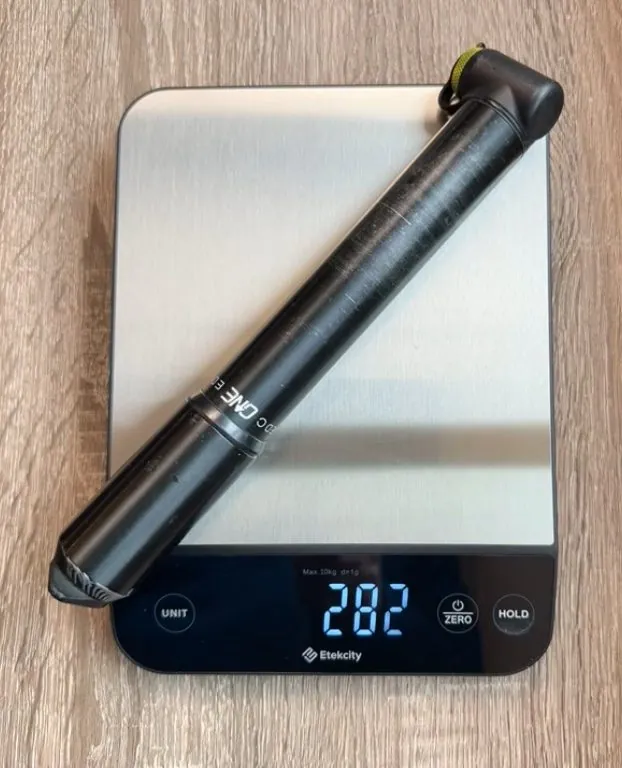 A floor pump? It’s a hell of a way to warm up before a ride, but probably not the best way. Most are notoriously inaccurate. And the way you connect the pump to the valve seems like a centuries-old design that hasn’t been improved on much or held up well over time. I’ve pinched my fingers and bent my valve stems more than I care to admit.
A floor pump? It’s a hell of a way to warm up before a ride, but probably not the best way. Most are notoriously inaccurate. And the way you connect the pump to the valve seems like a centuries-old design that hasn’t been improved on much or held up well over time. I’ve pinched my fingers and bent my valve stems more than I care to admit.
The economics are close to the same.
A basic floor pump will cost you $60, though you could spend 2 to 3 times or more for ones that are better made, have a booster, or a digital gauge. An entry-level hand pump runs $35, though a decent one that won’t have you pumping all day will cost a good deal more. CO2 inflators sell for $30 and up. A 3-pack of canisters goes for $10. Digital pressure gauges will set you back at least $40.
That all adds up to $175, but an enthusiast could and likely would spend more to get higher quality models of one or several of those items. That will get you two to three electric bike pumps that will do everything that the combination of tools I just priced out needs to do in combination, and a heck of a lot more efficiently.
ELECTRIC BIKE PUMP OPTIONS
While it is a fast-evolving category, I found more than a dozen brands selling battery-powered, reasonably portable, electric tire inflators designed for Presta and Schrader valves.
Alphabetically, the brands include Airbank, Anoutway, Cycplus, Fanttik, Flextail, Fumpa, GPUTEK, KEPEAK, QiCycle, RockBros, Topeak, and Topump. There are undoubtedly more. Some sell only one model, others make several for bike tires, and also for motorcycle and car tires.
Some of the same models are sold by different brands, and many have some of the same components. As with other parts of the cycling industry, there are likely a few manufacturers making products for many brands. All the models I tested came from mainland China.
Looking across all of the offerings, I ordered only those with a digital gauge that can easily fit in a small saddle bag or back pocket and that claimed the ability to fill 25mm road tires to 120 psi or 35mm gravel tires up to 50 psi at least two times.
As I’ll describe later, my testing showed they can refill modern-width tires to modern inflation levels at least three times.
If you flat more often than that on a ride, you’re having a really bad day and will probably run out of tubes or plugs before you run out of air.
Those with more capacity are often one-and-a-half to three times the size and weight of my target group and claim to provide five or more refills. These can be useful if you do a lot of multi-day adventures. They’re overkill to carry for a several-hour or even an all-day ride.
Electric bike pumps without a digital gauge, while somewhat smaller and lighter, have the capacity equivalent of a CO2 inflator and 1-2 cartridges. You’ll also need to carry a separate gauge if you want to know your inflation pressure. Some have lower power ratings, so they can take much longer to fill your tires.
MY PICKS AND MORE
I picked and tested six electric bike pumps that hit the size, capacity, and digital gauge sweet spot I targeted.
From left to right, they are the
- Anoutway AT1 Pro
- RockBros AS1 Pro Mini
- GPUTEK BG-BL01
- Cycplus AS2 Pro
- Flextail Tiny Bike Pump Pro
- Flextail Tiny Tire Pump ACS
Airbank, KEPEAK, and Topump sell what look to be the identical models, respectively, of the ones I tested from RockBros, GPUTEK, and Flextail.
The smallest, or in some cases only, electric bike tire inflators with digital gauges from Fanttik, Fumpa, QiCycle, and Topeak are far heavier than those I selected and too large to easily fit in a saddle bag, or even a bento box or frame bag and still have room for other tools or supplies.
WHAT MATTERS MOST WHEN CHOOSING ELECTRIC BIKE PUMPS
As I had no experience with electric bike tire inflators, I went into my testing looking to evaluate around a dozen criteria, not knowing which of these would really matter most in choosing between them.
I measured the size, weight, inflation speed, inflation reps, accuracy, heat, noise, and recharge time for each model. I tried to seat a tubless tire with several. I noted their battery storage capacity differences, where their displays were located, how they felt in my hand, and how easy they were to operate. I compared their prices.
As I’ll explain, what I believe matters most when choosing between these models is quite different than what I expected and from what others I’ve seen who’ve posted reviews have used to make their recommendations.
DIFFERENCES YOU WON’T NOTICE
Admittedly, sorting among all the available electric bike tire inflators for those that have a similar size, inflation capacity, and a built-in digital gauge already predetermined that there wasn’t going to be a lot of difference in those criteria.
Weight and Size
And indeed all six models weigh within 15 grams or a half ounce of each other at about 150 grams, or about 5.5 ounces.
These electric bike pumps are also quite similar in size. Their length, width, and thickness are within millimeters of each other, each having a footprint similar to a small bike computer like the Wahoo Bolt and the volume of a GoPro Hero 11 Black camera.
What sets them apart the most is the length of their nozzles. The GPUTEK (13mm or roughly ¾”), RockBros (12mm), and Flextail ACS (10mm) are the longest, while the Flextail Pro (0mm), Cyclplus (4mm or ¼”), and Anoutway (5mm) are shorter.
You won’t notice these weight and size differences when putting these models in your bike bag or back pocket.
Inflation Speed
Likewise, all but one of these electric bike pumps fill tires in roughly the same amount of time.
It took about a minute (54-64 seconds) to inflate my 700C x 28mm Pirelli P-Zero Race TLR RS tire on my ENVE SES 4.5 tubeless, hookless front wheel (25mm internal) from 0 to 70psi the first time with five of the pumps. It took a few seconds longer the second time, and slightly longer still (58-69 seconds) by the third time around with each inflator.
Similarly, using these electric bike tire inflators to pump my 700C x 40mm Tufo Gravel Swampero tire on a Hunt 40 Limitless, hookless front wheel (27mm internal) to 45psi took just a bit longer (56-70 seconds) with those same five pumps.
Unless you are testing these pumps side by side, or you have a musician’s sense of time, I don’t think most cyclists will notice a 5-10 second difference when they’re filling a flat at the side of the road.
If you’re using one of these inflators to add 5 to 10 psi to your tire before a ride, the inflation time difference between them will be indistinguishable. It certainly will be no more and likely far less than the time it takes to connect your floor pump, stroke it three or four times, disconnect it, pull out your digital gauge, and adjust the pressure down to where you want it.
A Slow, Odd Duck
The Flextail Tiny Tire Pump ACS was a notable inflation speed underperformer. It took 87 to 95 seconds to inflate the Pirelli to 70psi. Worse, I couldn’t get the Tufo gravel tire above 40psi within 2 minutes, at which point I gave up on it.
This pump also doubles as a tail light. With the included hardware, you can mount it on your seat post and set it to the typical flashing modes available in dedicated or radar tail lights.
While I tested the Flextail’s inflation capability on a full charge as with the other pumps, I can only guess that it’s design as both a pump and a tail light, and the draw on the battery when used as a tail light, likely diminishes its inflation speed and the number of inflations you can get from it when using it in both modes.
Accuracy, Heat, and Tubless Seating
I found no difference between the pressure my stand-alone Topeak digital gauge measured the inflator pressure at, and that measured by any of the electric bike tire inflators.
Likewise, with the silicone case covering the Anoutway, Cyclplus, and RockBros models, these inflators and the two Flexail and GPUTEK pumps that don’t use cases don’t get more than slightly warm after a full inflation of a road or gravel tire. It’s just not an issue.
Also, I found that these electric bike pumps are no more or less effective in seating a tubeless tire than a floor pump. Which means, you’re ability to get the tire seated with one of these pumps depends more on the tire and rim than the pump.
Some tires, like the Continental Grand Prix 5000 S TR, will seat with a floor or electric pump with no problem. Most other tires require a lot of aggressive, fast pumping or, more likely, a high-powered air compressor or a high-pressure, quick-release booster pump like the Topeak JoeBlow to get a tubeless tire seated.
Of course, if you need to put a tube in your tubeless tire after a flat, the pressure of the tube on the tire will cause it to seat the tire beads.
DIFFERENCES THAT SHOULDN’T MATTER
Inflation Reps
Many electric bike pumps market themselves in part on how many times you can inflate a tire on a single charge.
I’m not sure who is behind these campaigns, but most don’t connect with me. They promote the number of times you can inflate a 23mm or 25mm tire to 100 or 120 psi.
Those tire sizes and inflation pressures take me back 15 to 20 years.
Today, even if you’re riding a set of wheels with 21mm internal width hooked rims and 28mm clincher road tires, all but those who weigh more than 200 lbs or 90kg should be riding at no more than 75 psi or 5 bar pressure.
If you’ve got a modern road setup, you are probably using 28 to 30mm tubeless tires on 23 mm internal or wider rims. Even if they are hooked rims, you’re more likely going to be riding at pressures of 65 psi or 4.5 bar or less.
A modern gravel setup with 40mm tires, 25mm internal width, hookless rims, and tubeless tires will put you at 40 psi for a 200 lb, 90kg.
So I tested these electric bike pumps going from 0 to 70 psi with at 28mm road tire and 0 to 45 with a 40mm gravel tire.
With a fully charged pump, I got three complete inflations to 70 psi in the 28 mm road tire from the Cycplus and two Flextail pumps, and a fourth inflation to between 45 and 60 psi before the batteries died.
I got four complete inflations to 70 psi with the Anoutway, GPUTEK, and RockBros, and between 45 and 52 psi on the fifth.
So yes, there is a difference in how these perform on the number of inflation repetitions, but I don’t think those differences will matter. You’ll likely run out of tubes before you drain the battery on one of these inflators.
Noise
Some will object to the noise these electric bike tire inflators make, and no doubt, they are noisy. My tests showed they put out about 90 decibels, give or take 5 dB, an amount similar to what you’ll hear from a motorcycle or loud singing near you.
There are two differences you will notice. First, about 5 to 10 dB of the noise gets absorbed in the tire once you put the pump on the valve. So if the noise really bothers you, I suggest you don’t start one of these electric bike pumps until you’ve put it on the tire valve.
Secondly, they each seem to buzz at a slightly different frequency. Some are higher-pitched than others. I don’t know that there’s anything I would do differently knowing this, but I did take note of it.
If the noise really bothers you for the minute or so it will take to refill your tire or the few seconds to top it off, you can pack some earplugs.
Recharge Time and Storage Capacity
One of the most significant differences I found between these pumps, but one that also shouldn’t matter to all but the most impatient of us, is how long they take to recharge.
This is directionally, though not exactly, related to their battery storage ratings, measured in milliampere-hours or mAh.
The Cycplus, with its 420 mAh rating, took just 18 minutes to recharge after being fully discharged. The Flextail Pro (450mAh) at 21 minutes, and Anoutway (450mAh) at 23 minutes were the next fastest to recharge. Both the Flextail ACS (500mAh) and RockBros (450mAh) took 28 minutes to refill their batteries.
Not surprisingly, the GPUTEK with its 1000 mAh capacity battery took the longest at 48 minutes. What is surprising, and disappointing, however, is that the GPUTEK didn’t provide any more inflation reps than the faster charging, smaller storage capacity Anoutway and RockBros models.
As with the criteria above, these recharge differences shouldn’t probably weigh into your decision on which of these units to purchase. That’s because most of us will put our electric bike pump on a charger at the end of a week or month of rides and not return until the next day, the same way I expect most of us do when we recharge our bike computer, lights, power meter, shifters, or derailleurs.
DIFFERENCES THAT DO MATTER
By the end of my testing, I found three things that separated these models the most and were key to what led to my choice between them.
- Design, principally where the digital display is located
- Ergonomics, how they feel in your hand, and how easy they are to operate
- Price, their current and starting prices, and how they compare between models
Design
The Anoutway, Cycplus, and Flextail ACS digital displays and buttons are on the opposite side of the inflation nozzle. You can see and work them most easily when the wheel’s valve is closest to the ground, ideally positioned between 4:00 and 8:00 if you were looking at a clock.
In contrast, the Flextail Pro and RockBros display and buttons are on the same side as the inflation nozzle. That means you’ll see the display and can push the buttons more easily when the tire valve is closest to the top of the fork or between 10:00 and 2:00.
The GPUTEK’s display and buttons are on the broadest side of the inflator, making them most visible when the valve is between the top and bottom of the wheel, say between 8:00 and 10:00 or 2:00 and 4:00.
This video shows each option.
To avoid getting into the controversy about where best to position your valve when inflating your tires, I’ll acknowledge that cyclists have different preferences and habits.
Fortunately, if you have a strong preference for where you like to position your valve when you inflate your tires, you have electric bike pump options that will satisfy those preferences.
You certainly don’t need to see the display or buttons to operate the pump; you can set the pressure you want before putting them on the valve, and they each turn off when they reach that pressure. But, if you want to see what’s going on during inflation, each is best suited to a specific range of valve positions.
Ergonomics
Once you’ve chosen the model that suits your valve position preference, or if that doesn’t matter to you, the most significant functional difference between them is how these electric bike pumps feel in your hand and how easy they are to operate.
As with the ergonomics of bike shifters and brake levers, we each find the feel and performance that suits us best.
But let me point out some of the most obvious characteristics of each of these pumps and how I experienced them in hopes it will help you decide.
Along with the display screens, which appear to be the same on all the models except for the GPUTEK, each pump has three buttons:
- An on/off power button, which also starts and stops the pump
- A + (plus) button to increase the pressure setting
- A – (minus) button to decrease the pressure setting
Operating the + and – buttons together switches the display between PSI and Bar.
The Flextail Pro has the largest on/off button, and it sits directly below the screen. That’s the button you’ll use most often. You can operate it with your thumb, and it’s most prominently positioned.
The + and – buttons that you’ll use to change the pressure settings between front and rear tires or road and gravel bikes are smaller, sit just inside the edge adjacent to the on/off button. They can be operated with your thumb and are at either end of a rocker switch.
I also find the slightly coarse texture of the plastic pump body, which doesn’t need a silicone cover to insulate your hand from the heat, gives me a secure grip on the pump.
All of this, along with a nozzle that is recessed into the pump’s body to make it flush with the edge that contains both the display and on/off button, gives me the visibility, feel, and functionality I like the best when pumping my tires with the valve in the 10:00 to 2:00 position that I prefer.
In contrast, the RockBros model, which also has its digital gauge display and nozzle on the side that’s suited for a 10:00 to 2:00 valve position, has separate, medium-sized plus and minus buttons below the display.
The on/off button is on the pump body side, adjacent to and at the same height as the display. And while it’s ideally placed for a right-handed cyclist to operate with their thumb, it’s not as large as the on/off button on the Flextail Pro and not as tactile to operate, as it’s covered by a silicone sleeve that fits loosely along the RockBros pump edge.
The GPUTEK’s display and buttons are on the largest side of the pump body. While the +, -, and on/off buttons that are lined up left to right in that order are no larger than the average size of the other models, their position on the side rather than the edge of the pump makes them easy for a righty to reach and operate with your thumb.
This pump is the only one that is ideally suited for the valves placed in the 8:00 to 10:00 or 2:00 or 4:00 positions. Its display shows both the pressure in the tire and the target pressure, the latter in a smaller green font.
It has a small light you can turn on near the nozzle, I assume, to help you find the valve in the dark. You also get a landyard attached to the pump.
I don’t see much value in seeing the target pressure, the light, or the landyard, but if you do, well, there’s that for you.
The Cycplus and Anoutway ergonomics are very similar. Both have their digital gauge display on the opposite edge of the nozzle and the round on/off, +, and – buttons lined vertically and in that order beneath the display. Each uses a silicone cover to protect your hands from overheating.
The Anoutway buttons are about the same size as those of the RockBros and GPUTEK. Cycplus’ buttons are about half the diameter. I also noticed the more rounded edges of the Anoutway’s body than those on the Cycplus, which made it a bit easier to hold.
Lastly, the Flexplus ACS has display, on/off buttons, rocker +/- switch, and tail light lined up vertically in that order on the side opposite the inflator nozzle. The buttons are as small as the Cycplus buttons, but they require more travel to trigger them. And, if you hold the on/off button in too long, the tail light will begin flashing, something I inadvertently did several times.
It really seems like Flextail tried to do too much with the ACS and made ergonomic compromises to create this dual-purpose unit.
Prices
For products whose most significant functional differences are in their design and ergonomics and vary so little in their size, weight, and performance, it’s hard to see any rationale for their pricing differences other than overhead costs, profit margins, or profit goals.
The GPUTEK is the least expensive at US$44.99. It’s “discounted” from a regular price of US$49.99, essentially the same price as the same model sold under the KEPEAK brand (click the company names to see current prices).
In The Know Cycling is ad-free, subscription-free, and reader-supported. If you want to help keep it rolling without any added cost to you, buy your gear and kit after clicking the store links on the site. When you do, we may earn an affiliate commission that will help me cover the expenses to create and publish our independent, comprehensive, and comparative reviews. Thank you, Steve. Learn more.
At the other end of the price range, the Cycplus sells for US$109.00 on Amazon or US$104.49 direct from Cycplus with code ITKC5.
Between those, the Anoutway is priced at US$75.99, down from its regular $85.99 price.
The Flextail Pro sells for US$64.60 with code ITKC15 discounted from its regular US$82.99 price and less than the same model sold by Topump for US$67.99, regularly US$79.99.
Flextail’s ACS model sells for US$72.25 with code ITKC15 discounted from its regular US$99.99 price.
Finally, the RockBros pump sells for US$83.99 on Amazon and US$99.99 direct from RockBros, while the same pump branded by Airbank goes for $67.99 on Amazon.
As we’re in the midst of the trade war between China, where these pumps are made, and the US, the largest cycling market for cycling products and the home of Amazon, prices and availability will likely change from what I’ve written above, though I won’t attempt to predict in what ways.
Click on the links for the ones you’re interested in to see the latest.
MY RECOMMENDATIONS
After sorting through all my tests and evaluations, and considering the price differences, I can enthusiastically recommend two models and offer one runner-up.
Flextail Tiny Bike Pump Pro – US$64.60 with code ITKC15
The Flextail Pro brings the best combination of design, ergonomics, and price, with no disadvantages to other units in differences you won’t notice (weight, size, inflation speed) or differences that shouldn’t matter (inflation reps, noise, recharge time). It’s a better choice than the RockBros or Airbank for those who prefer to inflate their tires with the valve in the 10:00 to 2:00 position.
If the Flextail Pro price jumps or is out of stock, check out the price and availability of the same model, branded by Topump, that sells for more as of this update.
GPUTEK Mini Bike Tire Air Pump – US$44.99
The GPUTEK is clearly the lowest-priced model and the only one I tested that suits those of you who prefer to position your valve at a quarter to (8:00 to 10:00) or a quarter past (2:00 to 4:00) the hour.
Its buttons, while not as large as the Flextail Pro’s, are sensibly placed on the largest side of the pump’s body and easy to operate for righties. The GPUTEK’s novel display screen, nozzle light, and landyard may also appeal to you.
While I don’t think it should matter to most, know that the GPUTEK took 48 minutes to recharge compared to the Flextail Pro’s 21-minute recharge time. It did, however, get a 4th full inflation, one more than the Flextail Pro.
If the GPUTEK isn’t available or the price has increased when you look for it, check out the KEPEAK that sells what looks to be the same model for $5 more.
Anoutway Tiny Bike Pump AT1 Pro – US$75.99
If you traditionally inflate your tires with the valve at 4:00 to 8:00 and can’t see yourself breaking that habit, the Anoutway is your best option.
Its design and ergonomics aren’t as good, in my opinion, as the Flextail Pro or GPUTEK, but it’s notably better than the Cycplus and far superior to the Flextail ACS, which are also designed for the same valve position.
Other than getting four full inflations from its battery, its performance on all the other criteria isn’t meaningfully different than the other electric bike pumps.
* * * * *
Thank you for reading. Please let me know what you think of anything I’ve written, or ask any questions you might have in the comment section below.
If you’ve benefited from this review and want to keep new ones coming, buy your gear and kit after clicking the store links in this review and others across the site. When you do, we may earn an affiliate commission that will help me cover the expenses to create and publish more ad-free, subscription-free, and reader-supported reviews that are independent, comprehensive, and comparative.
If you prefer to buy at other stores, you can still support the site by contributing here or buying anything through these links to eBay and Amazon.
You can use the pop-up form or the one at the bottom of the sidebar to get notified when new posts come out. To see what gear and kit we’re testing or have just reviewed, follow us by clicking on the icons below.
Thanks, and enjoy your rides safely! Cheers, Steve
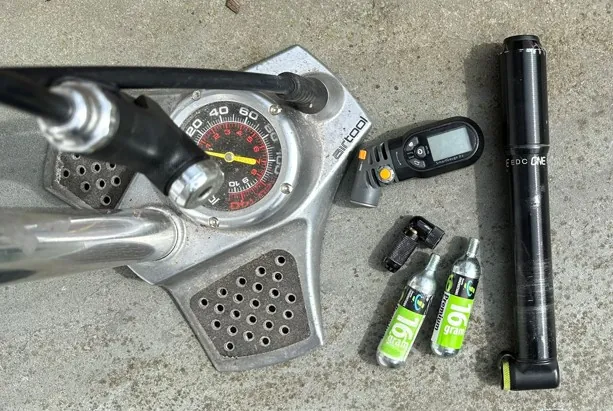
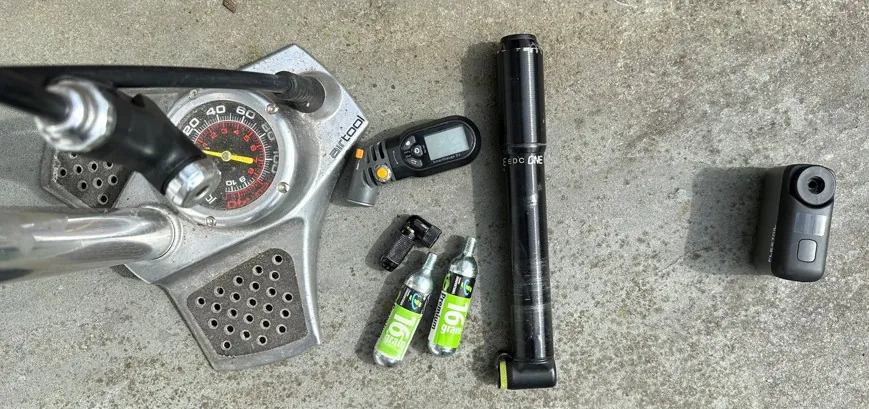
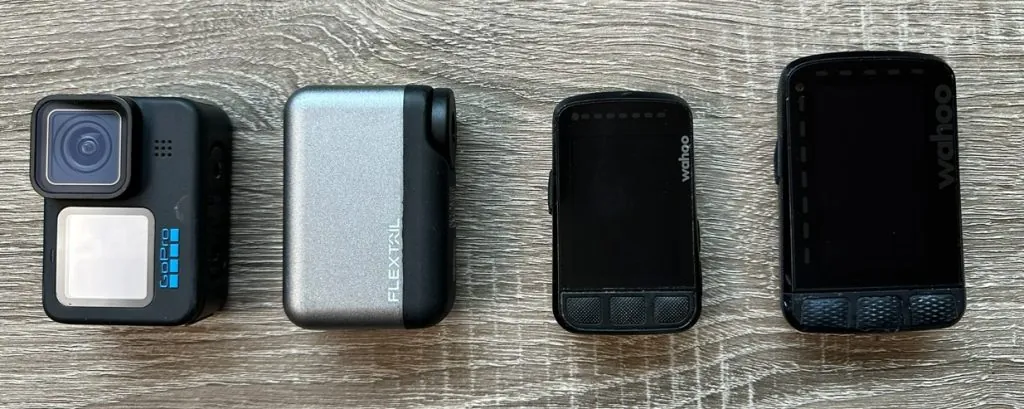

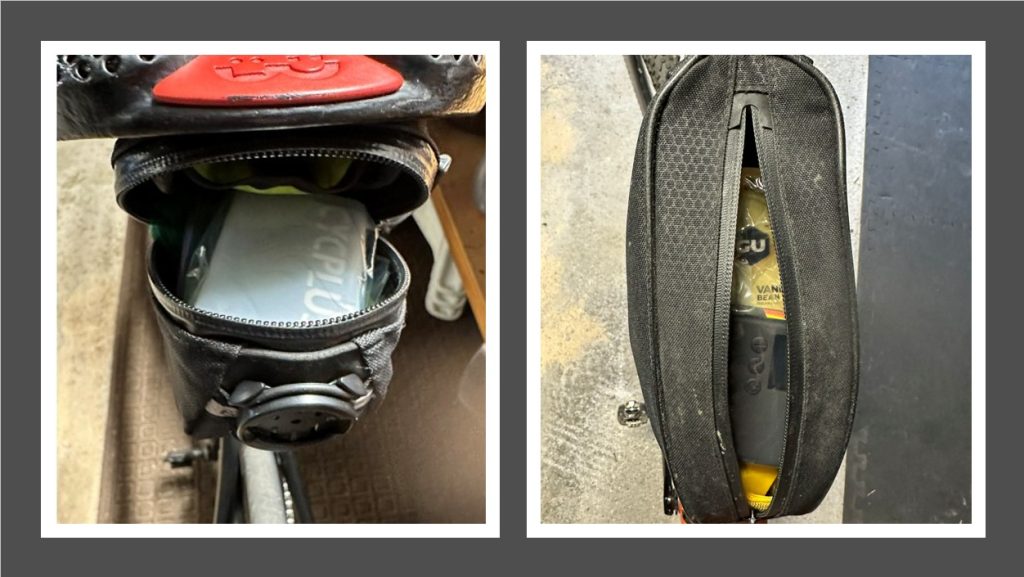
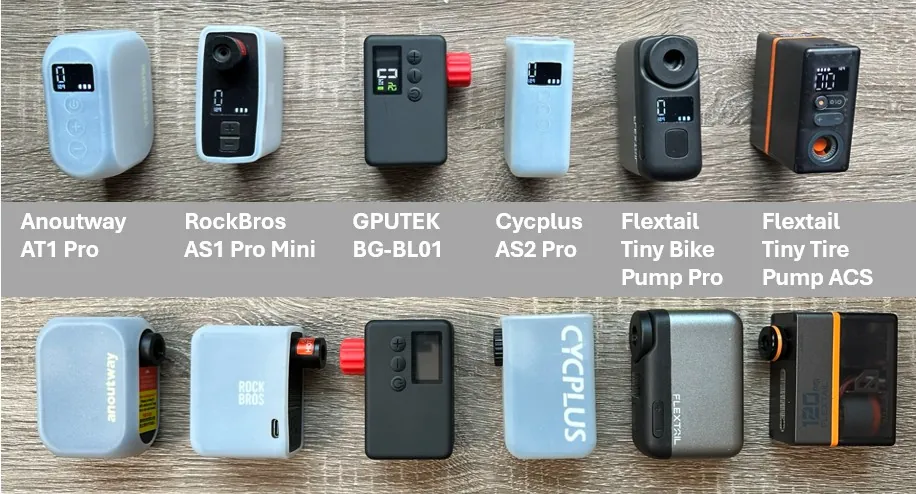




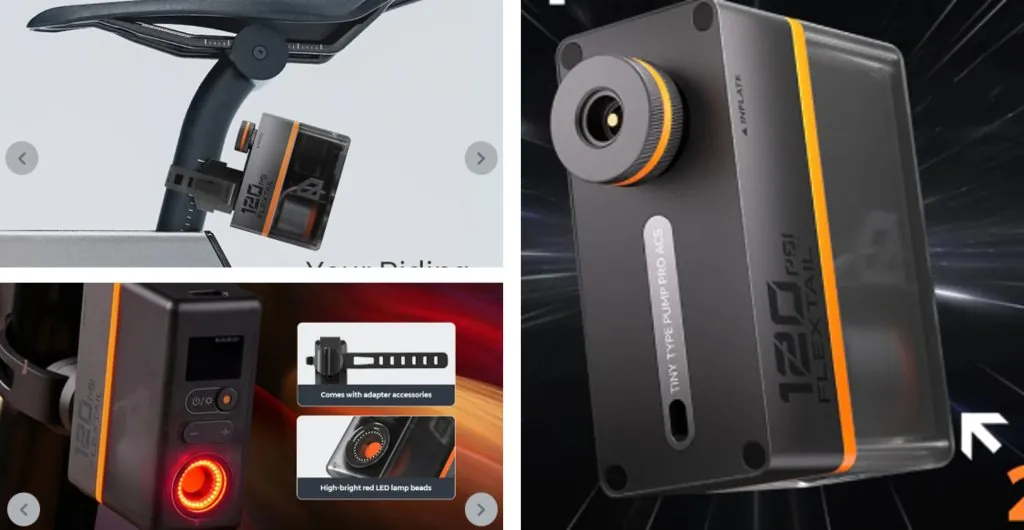


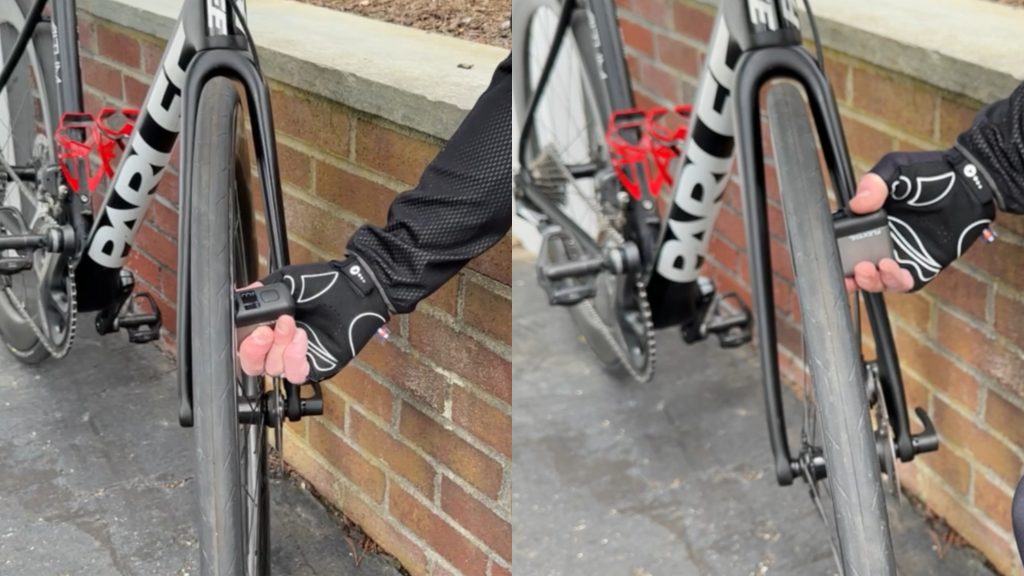
Amazon has the top pump, same as flex pump for 64.59
Yes, I mentioned and linked to it on Amazon in the post.
Did you happen to test any of these with Reserve Fillmore valves? I would imagine they will work just as well.
I’ve not, but I agree that they probably will.
Any idea how well these hold their charges?
I’ve not yet needed to use my Cycplus AS2 for real, and so it’s tucked deep in my saddle bag and very easy to forget about. I know I should either charge it every time, like a light, or have two and try to swap the one in the charger with the one in the bag on a routine basis… However, I am living on the edge for now.
It would be great to know, for example, that they can be counted on for at least 90% for a few months, but that feels overly optimistic.
I agree. It would be good to know. I’ve taken to recharging my light, radar, and bike computer every Sunday, and my power meter pedals and group set the first of every month. I’ll add the electric bike pumps I keep in my saddle bag and bento box to my monthly recharging schedule.
I’m also curious to see how many times I can recharge the battery on these things before they crap out. I’ve recharged each of the ones I tested at least 5 times, and the one I keep on my workbench at least 10. So far so good.
Great job! Like you, Steve, I essentially knew nothing about these pumps other than of their existence. Your logic in making the case for replacing existing tire inflation/measuring methods is impeccable. Like you, I’m pretty astonished these pumps not only completely replace current methods, but that they do everything better! Finally, the value in your testing each one that met your well-considered criteria saves everyone the time and expense of having to trial-and-error to learn which one(s) work best for each individual’s preferences. Most practical and useful article you’ve done in the 5 years or so I’ve been a subscriber, IMHO. Kudos!
Super nerdy, right? Glad you like it Naran.
FYI: GPUTEK Mini Bike Tire Air Pump on Amazon already 10% off at $44.99 as noted, now has additional 10% coupon (saving an additional $4.50). Yay!
Thanks Steve for a super helpful review! I’ve been looking to get one of these, and now I’m sold!
John, Appreciate it, especially coming from you. 🙂